Chefs of team 62 proved that Hue cuisine had not only luxurious royal food but also interesting delicious rustic ones. Hue talented chefs just needed to work with creativity to renovate them to classy dainty dishes.

A part of Indochine Palace Hue team’s kitchen table.
On
the kitchen table, there were a couple of traditional carrying baskets; each of
them was full of thorny pepper tips (Zanthoxylum nitidum DC.) – a common spice
in Middle of Viet Nam. Next to it was a whole robust fruity tree of wild maracuja
or bush passion fruit (Passiflora foetida) and a corner full of fresh
good-looking vegetables.
The
most remarkable point was that on each type of spices hung a nice piece of
paper printed basic information, from its origin, its usage, to how to combine
with other ingredients. The presentation speech was also printed and hung on
the basket. That’s how team 62’s chefs – Indochine Palace Hue – performed their
sincere to judges and visitors, by providing relevant information about their
golden dishes, and that’s also a tip to save more time. They were placed in the
very first line, where attracted all attention from judges and reporters while
many dishes in the menu were waiting to be completed.
“Last
year we got into this round, too, but because of emergency situation at work,
we must drop. What a pity! We determined to make it this year”, said chef Tran
Huy Cuong with his bold ascent of Hue. Together with his colleagues Tran Phong
Huy and Le Duy Binh, those chefs dragged a whole “fan club” including all
family members to the Northern semi-final round.
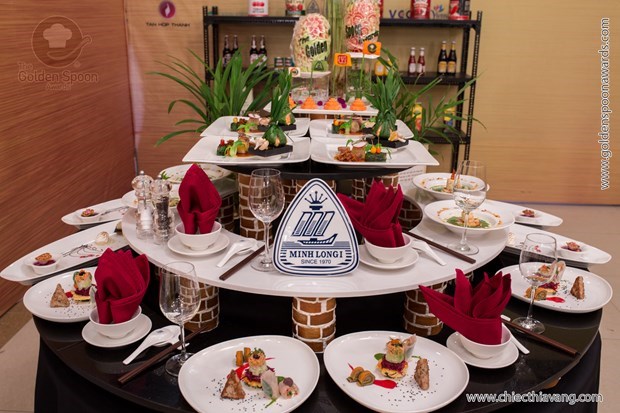
Not only focusing on the quality but team 62 also invested in decoration by recycling paper cores and using granite blocks to set a unique party table in Northern semi-final round.
Last
preliminary, they had introduced all types of rural ingredients, telling a
story from royal palace to kitchen corner of working class. In this round, they
were confident to apply modern fusion style to rustic traditional dishes. Their
golden menu includes: 1) Pomelo and green rice rolled fresh cheese in basil
sauce – Salmon salad with beets and annona – Sautéed fresh figs – Rainbow
smoked salmon rolls served with beet and passion fruit sauce; 2) Sponge gourd,
wild maracuja, and river black tiger prawn soup served with soft shrimp cake;
3) Tre chicken steamed with raw sea salt grains and pollens, served with ginger
caramel – Baked beef and thorny pepper tips rolls, served with stewed Da Le
jackfruits and Tinh Tam lotus root, rice with cochinchin gourd and lotus seed,
and grilled garlic; 4) Purple yam dessert, lemon-grass gingko in pink-lime
sauce – 2 flavors chewy sesame candies – Thuy Bieu Thanh Tra pomelo soft cake.
Chef
Tran Huy Cuong presented, “Royal cuisine is Hue heritage and the brightest
pride, which has been known by domestic and international visitors. We do have
advantages if we bring our royal cuisine us to the contest. However, we’d love
to prove that Hue cuisine has not only luxurious royal food but also
interesting delicious rustic ones. From the most common ingredients, we would
create and renovate them to classy dainty dishes.” Because of that reason,
those Hue chefs took the chance to introduce as many of their remarkable dishes
as thay could. For examples, their appertizer included 4 dishes: Pomelo and green
rice rolled fresh cheese in basil sauce – Salmon salad with beets and annona –
Sautéed fresh figs – Rainbow smoked salmon rolls served with beet and passion
fruit sauce.
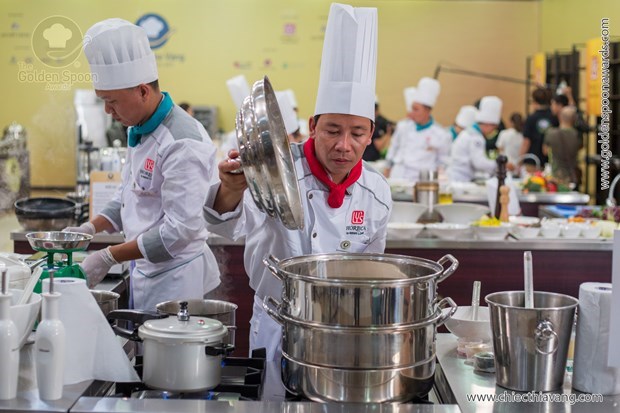
Chef Tran Huy Cuong took care of every step of his cooking process.
Chef
Huy Cuong presented that the appetizer was a resonance of Hue regional
specialties and highly nutritious food, displayed with a delicate theme. First
to mention was salmon salad with annona and beet, an enterprise point when they
decided to apply fusion method. The next dish was alternated from traditional
fig salad to sautéed figs, a big step to place the dish on classy party tables.
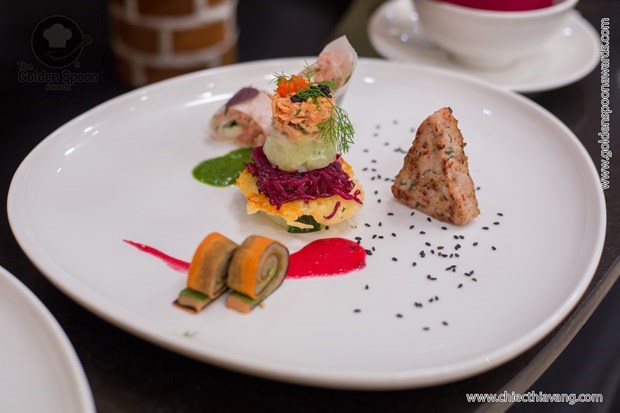
Appetizer included Pomelo and green rice rolled fresh cheese in basil sauce – Salmon salad with beets and annona – Sautéed fresh figs – Rainbow smoked salmon rolls served with beet and passion fruit sauce.
According
to team 62 chefs, that time of the year was right at peak season of pomelo so
that they decided to use the best and succulent pomelos to make special dish
with shitake mushroom, fresh cheese, and basil sauce, which all in a roll
expressed a very autumn bite. To create the best after-taste of the appetizer,
they ended the first course by rainbow smoked salmon rolls served with beet and
passion fruit sauce. That was a unique combination between Asian and European
cuisine, in which nutritious salmon and nourishing beets and passion fruits
were totally enough to persuade any picky gourmet.
With
the same idea, the seafood soup (sponge gourd, wild maracuja, and river black
tiger prawn soup served with soft shrimp cake) was alternated from traditional
soup. On the wild maracuja vines hung a piece of paper with clear note: Beside
nutritious food, wild maracuja is also a natural medicine. It works as natural
sedative or anti-insomnia. A dish from those miracle leaves is not only highly
nourishing but also healthy and cure-able, especially for people with sleeping
issues.
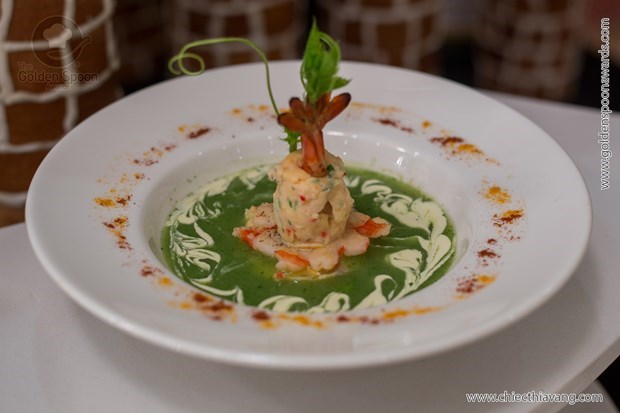
Sponge gourd, wild maracuja, and river black tiger prawn soup served with soft shrimp cake.
Sliced
gourd and wild maracuja leaves were medium cooked to preserve the lively green
while fresh wild caught shrimps from Tam Giang lagoon were sautéed. Soft shrimp
cake was made from grinded shrimps, cream, egg whites, and seasoning to taste.
The dough would be steamed to cooked then served as side dish. Chef Huy Cuong
said, “To place this dish on a party table, we have to internationalize it by
serving the soup with soft shrimp cake and sautéed shrimps. The soup went
through a delicate process to preserve natural color of wild maracuja leaves
and vitamins. To elevate a rural food to bigger market, chefs really need to
skillfully work with creativity.”

Tre chicken steamed with raw sea salt grains and pollens, served with ginger caramel – Baked beef and thorny pepper tips rolls, served with stewed Da Le jackfruits and Tinh Tam lotus root, rice with cochinchin gourd and lotus seed, and grilled garlic.
For
the main course, our Hue chefs steamed chicken thighs with raw sea salt and
pollen. They chose Tre chicken, a naturally raised chicken in Nam Dong area.
Chicken thighs cooked by the heat from sea salt would remain their smooth
flavors while pollen would enrich nutritious value of the dish.
A
Luoi beef tenderloin was rolled with thorny pepper tips and lolot leaves then
baked, creating a robust and impressive taste of wild spicy leaves. The
luxurious meat was served with rural produces from the former capital, such as
Da Le jackfruits, Tinh Tam lotus roots and seeds, and cochinchin gourd and rice
wrapped in pandan leaves. The sauce, in the other hand, was quite simple yet
memorable – ginger caramel sauce.
To
complete the menu of Golden Dishes, team 62 brought a fusion dessert to please
the jury as Purple yam dessert, lemon-grass gingko in pink-lime sauce – 2 types
of Hue sesame candies – and Thuy Bieu Thanh Tra pomelo soft cake. Traditional
famous sweet of Hue were 2 types of sesame candies, chewy and crispy; modern
mark was Thuy Bieu Thanh Tra pomelo soft cake; and renovated dish was yurple
yam dessert with lemon-grass gingko in pink-lime sauce. The combination of
three dishes would leave rich yet unique taste of each and subdued the judges.
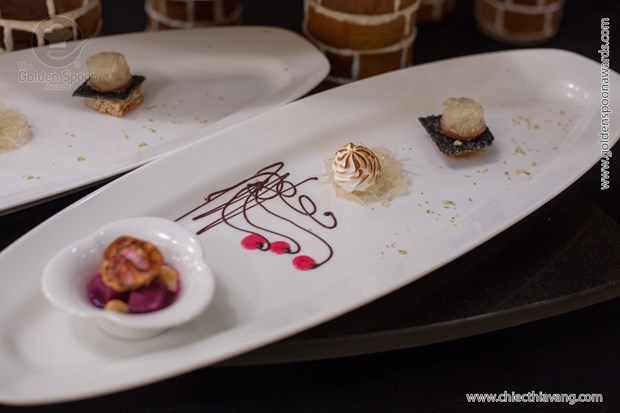
Purple yam dessert, lemon-grass gingko in pink-lime sauce – 2 types of Hue sesame candies – and Thuy Bieu Thanh Tra pomelo soft cake.
Some
people had concerned about processing time for that enormous menu and even chef
Huy Cuong had to atmit after 120 minutes cooking, “If I have 20 minutes more,
the dishes would be perfect. Anyway, we did complete our menu on time and
introduce full courses of Hue cuisine to more people. That’s our honor and
truly pleasure.”
By Nguyen Trang